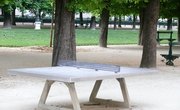The art of making firearms goes back hundreds of years to the most crude inventions propelling large lead balls with the aid of explosive powders. Today firearms are much more complex and advanced. Traditionally, all weapons were mounted on a wooden stock. Today, a stock can be made using fiberglass or composite resin. In order to pour a resin stock you need to form the mold for the stock. This can be accomplished with little difficulty.
Items you will need
Wooden stock
Fiberglass and resin
Plastercine
Wax (wood or furniture wax)
Rolling pin
Modeling or potters clay
Gloves and respirator (common mouth mask)
Select a wooden stock in the shape that you prefer, or one that will fit the type of weapon you're trying to build.
Wax the entire stock. Fill any cavities on the stock with plastercine.
Make a bed of modeling clay using a rolling pin. Ensure that the bed is at least 2 inches deep, and longer and wider than the stock by at least 6 inches in all directions.
Place the stock onto the bed of modeling clay. Build up the modeling clay around the stock until the stock is halfway submerged in the clay.
Make quarter-sized diameter circular depressions in the clay around the stock, spaced about 3 inches apart. These will be the key-ways (joining points) for both mold halves to join adequately.
Build up the edges around the modeling clay bed perimeter to a height of 2 inches. This will be the dam to hold the resin.
Wax the clay bed thoroughly. Pour an even layer of fiberglass and resin over the stock and clay. Allow the first layer to settle for a few minutes. Add two more layers. Allow the mold to dry for 24 hours. Separate the top and bottom mold pieces carefully. Remove the wood stock. You now have a resin mold for your rifle stock.
Warnings
- Never attempt maintenance on a loaded firearm.
- Use adequate skin and respiratory protection when making the mold.
- Only pour the mold in a well ventilated area.
Tips
- Note that molding the resin is only the beginning of making an artificial stock. Numerous intricate details must be added and modified after the initial mold has been pulled.
References
Tips
- Note that molding the resin is only the beginning of making an artificial stock. Numerous intricate details must be added and modified after the initial mold has been pulled.
Warnings
- Never attempt maintenance on a loaded firearm.
- Use adequate skin and respiratory protection when making the mold.
- Only pour the mold in a well ventilated area.



